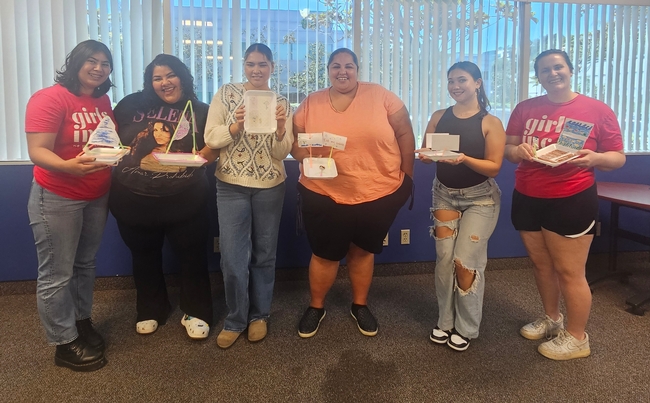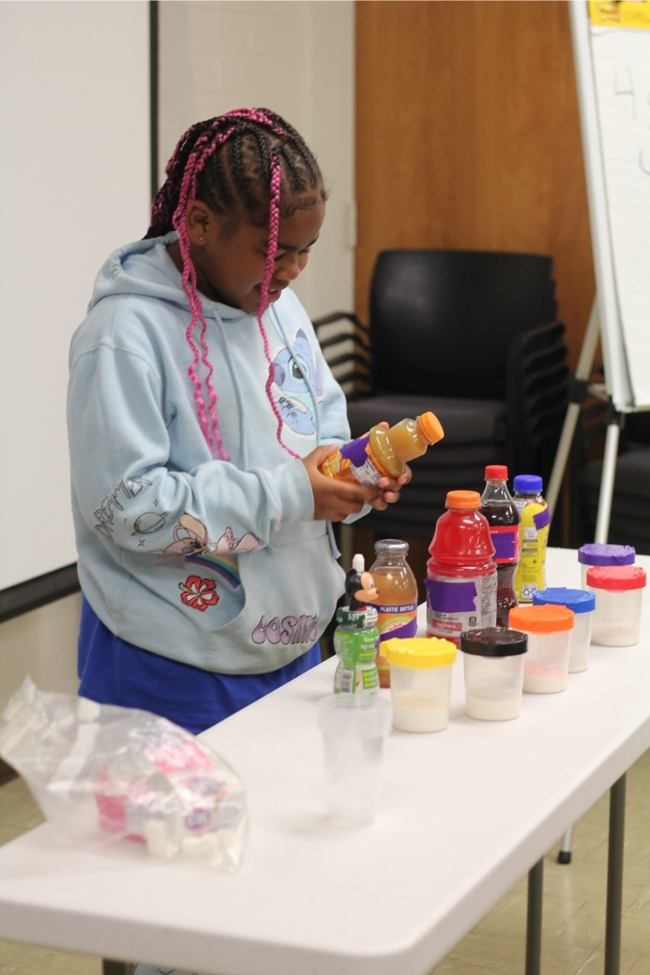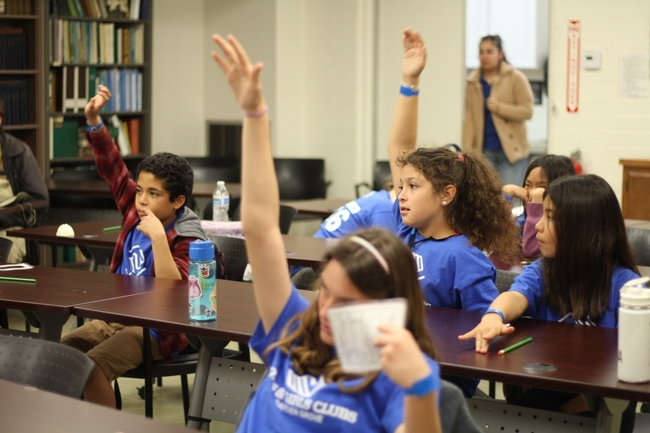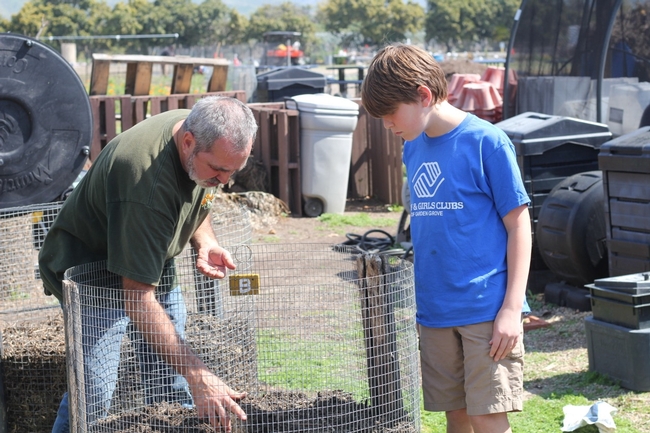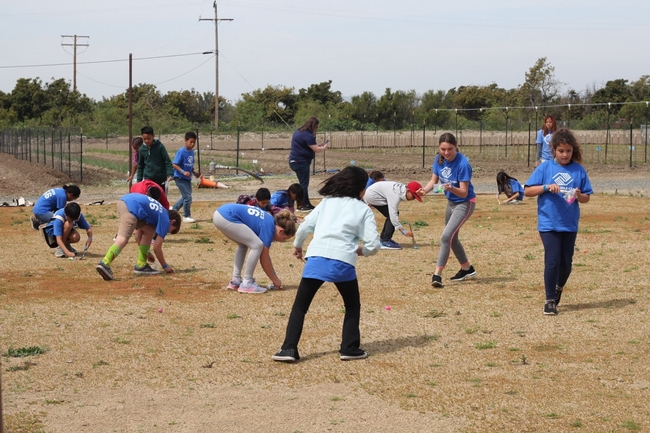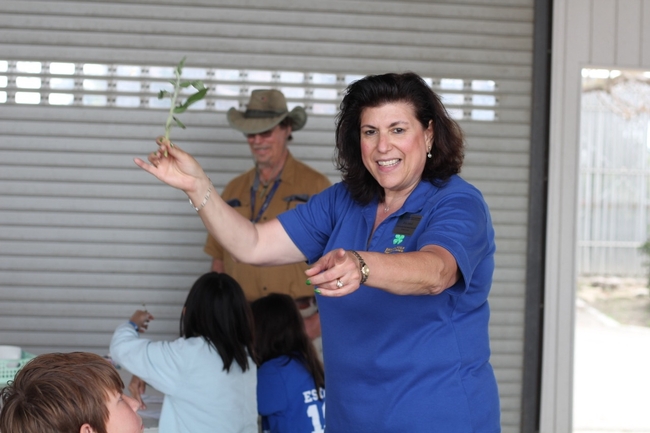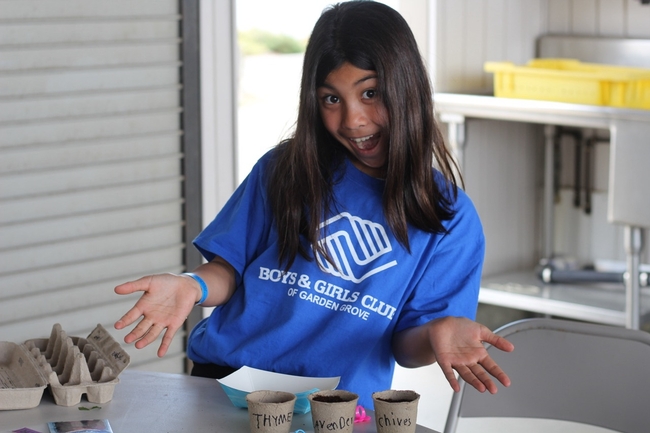- Author: Michael Hsu
Holmes brings a lifetime of service, mentorship to California 4-H program
Growing up in rural Alabama, Kimberly Sinclair Holmes – the new statewide director of California 4-H – experienced firsthand the enduring value of youth development programs in a limited-resource environment.
From first grade through seventh, Holmes participated in a summer program hosted by nearby Tuskegee University, a historically Black land-grant university. Every day, Holmes would play sports like kickball and softball, enjoy craft projects, and strengthen the English and math skills she learned in school.
“We didn't necessarily have all the amenities you might have in a more urban setting, so the program allowed us to socialize with friends and keep relatively up-to-date on our skills,” Holmes explained. “We learned something new each week, too.”
In her new role overseeing 4-H across the most populous state in the U.S., Holmes said she aims to ensure that those types of invaluable opportunities are available to all young people. Affiliated with the nationwide youth development program, 4-H in California engages approximately 58,000 youth each year and is administered by University of California Agriculture and Natural Resources.
“My emphasis is – and will be – on ensuring that every youth in the state of California knows what 4-H is – and how to connect in whatever way is meaningful for them, whether in the traditional club setting, an expanded learning or after-school program, one-day events or online activities,” said Holmes, who started in her director position in July.
Holmes' past shapes her path
As a child, Holmes, whose paternal grandfather was a sharecropper in the Deep South, helped her family grow fruits and vegetables in their garden – that is, when she and her siblings weren't romping through the countryside on the outskirts of Tuskegee, a small town near Montgomery, the capital of Alabama.
“We were either chasing the chickens and turkeys, or the chickens and turkeys were chasing us, depending on the day,” she laughed.
The youngest of eight children, Holmes said she was very much a “daddy's girl” who loved to watch her father tinker with the family automobiles, in the shade of a leafy tree on sweltering 100-degree days.
Holmes' early interest in mechanics and her fix-it mentality shaped her initial academic and career pursuits. After graduating from Tuskegee University with a bachelor's degree in electrical engineering, she worked as a product systems engineer in the auto industry for about seven years.
As a young professional in Kokomo, Indiana, Holmes got involved with Big Brothers Big Sisters. She was paired with a “little sister” – appropriately named Destiny – and Holmes' experiences helping Destiny navigate the challenges in her life demonstrated the impact that mentorship can have on young people.
“Growing up in a limited-resource rural environment, I was always aware of and tuned into whether the young people coming behind me would have the same opportunities, and the extent to which I might be able to help them,” Holmes said. “The more I received mentoring from professionals who were helping to shape my career, the more compelled I felt to pass that along – to help other young people figure it out.”
After conversations with colleagues and self-reflection on how to make a difference in society, Holmes pivoted from engineering car parts to engineering programs in higher education. She took an administrative job at the University of Texas, Dallas, where she would serve as assistant dean in the School of Engineering and Computer Science, as well as an advisor to five different student organizations on campus.
For that service, Holmes received an award for mentoring from the National GEM Consortium, whose mission is to provide financial support to persons from underrepresented groups who pursue graduate degrees in Science, Technology, Engineering and Mathematics (STEM)-related fields.
Holmes was on her way to a new career in guiding young people through school and life.
Continuing a family legacy of youth service, mentorship
Looking back, Holmes said it was influential elementary school teachers and her own parents who showed her the immense value of a career helping and serving others. Holmes' parents were involved in several ministries and managed a gospel singing group that traveled all over the South.
Following her parents' example, Holmes joined a youth ministry as an undergraduate in college, where she first began talking with local youth about their challenges, frustrations, aspirations and dreams.
“I saw so many young people struggling with their identity and what they could do as a career. It really troubled me that they were struggling as much as they were,” Holmes said. “I asked myself, ‘What are you doing to help them figure it out?' That's really where it started.”
All along her professional and academic path, Holmes continued to serve as a mentor and guide by having difficult conversations about setting and realizing life goals. After attaining her Ph.D. in public policy/administration from UT Dallas, she progressed through a series of administration roles at higher-education institutions throughout the South.
Holmes eventually landed at Alabama A&M University, where she was serving as assistant Extension director and a 4-H state program leader in the Alabama Cooperative Extension System, prior to joining UC ANR.
A vision for the future of youth development
Like her “shade-tree mechanic” father, Holmes still enjoys tinkering in her free time. She will also apply her engineer's perspective to optimizing 4-H programs in California, which offer young people hands-on experiences on everything from animal sciences to robotics, and from fine arts to programming languages.
While praising the “phenomenal team” of UC Cooperative Extension advisors and educators and 4-H support staff, Holmes will also be looking to build on their innovations.
“There are several strategies you would use to improve, measure and improve efficiencies in an engineering system; but there are also several strategies and processes you would use to measure and improve systems in an organization,” Holmes said. “I think what I bring uniquely to this role is the ability to see and integrate those strategies for even greater organizational effectiveness and growth.”
After listening to and learning from her team across the state, Holmes is eager to develop and calibrate new ways to reach more young people – as the benefits of 4-H are needed more than ever. The concerns of youth she has heard throughout her career are even more pronounced and pressing now.
“It's something I worry about constantly, especially post-pandemic – the data about how our young people are struggling with having positive images of themselves and hope for the future,” Holmes said. “There's a lot of despondency; there's a lot of anxiety; there's the issue of chronic absenteeism; and the number of youth who have now reported a diagnosed mental health disorder is alarmingly high.”
Aside from the myriad life and work skills that 4-H activities can teach young people, participation in 4-H also helps them see, for themselves, their intrinsic worth as a person – outside of external influences such as social media. A sense of belonging within a supportive community, like the one that 4-H cultivates, can guide young people to that truth.
“I want to be absolutely certain you know that you are worthy and you are valuable – you have something to offer, and there's something unique and special about you,” Holmes said. “You have unique gifts and talents that only you can exercise in the world. Because only you can exercise them in the world, it's critically important that – before you give up, give in or give out when the pressures of life weigh on you – you have people around you who will help you through those difficult moments.”
Holmes believes that when communities create spaces in which all youth feel a sense of belonging and are able to connect their interests and abilities with possible careers, young people will make significant progress towards reaching their full potential.
“This achievement will then contribute to a greater quality of life for the youth, as well as communities statewide,” she said.
- Author: Michael Hsu
Event at FIRA USA in Yolo County includes look at agricultural robotics, automation
The FIRA USA ag tech conference, Oct. 22-24 in Woodland, showcases the latest robotics and automation innovations. A special breakfast during the event will support tomorrow's leaders, scientists and engineers who will realize the potential of those technologies.
Proceeds from the breakfast (Thursday, Oct. 24, 7:30 to 9 a.m. at the Yolo County Fairgrounds) will benefit higher education scholarships for 4-H youth participants interested in applying technology to a wide array of agricultural practices.
During the breakfast, attendees will hear from 4-H alumni – including Glenda Humiston, University of California vice president for agriculture and natural resources – on the impact of their participation in the program.
As a leading nationwide youth-development organization, 4-H delivers research-based, positive youth development practices through its community-based programs. Youth gain life and work readiness skills through hands-on projects. Studies have shown that youth who engage with 4-H programs are more likely to:
- Achieve academically
- Serve in leadership roles in school and community
- Engage in some form of community service
“4-H clubs, project teams and after-school programs develop skills in areas ranging from animal science to robotics, and from natural resources to coding,” said California 4-H Director Kimberly Sinclair Holmes, who will speak at the breakfast. “Scholarships help ensure those seeds of interest and passion blossom into meaningful careers that contribute to agriculture and society.”
Tickets are $100 each and can be purchased at https://bit.ly/4-HFIRAEvent.
The ticket includes all-day access to FIRA USA, touted as “the largest robot playground in the world,” where attendees can get an up-close look at laser weeders, autonomous harvesters, drone applications and a host of other ag tech innovations.
FIRA USA is a collaboration of GOFAR (Global Organization for Agricultural Robotics), Western Growers, UC Agriculture and Natural Resources, and The VINE.
- Author: Saoimanu Sope
First program of its kind in area establishes free seed library, community garden
One of the many things that make University of California Cooperative Extension in Imperial County unique is its close proximity to the U.S.-Mexico border. Its geographic location, with a border town called “La Frontera” by locals, infuses the UC Master Gardener Program in this area with intercultural knowledge.
In 2022, UCCE launched its first UC Master Gardener Program in the county and has maintained a cohort of 20 participants since then. Kristian Salgado, the program's first coordinator, said the volunteers offer a range of skills to the gardening community.
“The clientele that our volunteers serve tend to be individuals who have gained their gardening knowledge and experience from tending to plants in their homeland of Mexico,” said Salgado. The volunteer UC Master Gardeners of Imperial County reflect the region's predominantly Latino demographic, making it easier for volunteers to connect with their clientele.
“Nopales, chiles, citrus…residents in this region know how to take care of these plants. They've done it all their life. But when you have a program like the UC Master Gardener Program, you can use science to explain why their practices worked all these years,” said Salgado.
According to Salgado, the UC Master Gardener Program can be perceived as too academic for some residents. “It's not a bad thing, but I had to digest the information myself, even the UC Master Gardeners, and figure out how to deliver it in a way that was relevant to everyone,” she added.
As a starting point, Salgado used English and Spanish materials from neighboring counties like “A Garden of Words/Un jardín de palabras”, developed by the UC Master Gardener Program of Los Angeles County.
One method that helped engage volunteers and residents during classes was the use of culturally significant seeds like chiltepin peppers – seeds that Salgado deems a “must-have” if you are a gardener of Mexican heritage.
“When we focused on plant propagation, the volunteers that I worked with agreed that we should propagate plants that our residents were familiar with and use in their everyday cooking,” Salgado explained.
This same approach was employed at the free seed library and demonstration garden – both established and maintained by the UC Master Gardener volunteers at the City of Imperial Public Library. During the warm season you can find Roselle (Hibiscus sabdariffa L.), known to make agua de jamaica, in the seed library – something you won't easily find in grocery stores. In the demonstration garden during the summer, you'll notice a variety of peppers such as chile güero, jalapeño, serrano and habanero.
As the UC Master Gardener coordinator for Imperial County for the last two years, Salgado has focused her leadership on establishing a program that would generate opportunities for UC Master Gardener volunteers to create projects that are reflective of their interests, align with the program's mission and serve all residents in the county. The demonstration garden, which is the first community garden established in the city of Imperial, is an outcome of Salgado's vision.
UC Master Gardener Program reflects, connects community
Eliza Barajas, UC Master Gardener of Imperial County, who works at the library during the week and has witnessed the impact of the garden, said it gives her a sense of pride. “I moved to the [Imperial] Valley a year ago and I was looking for a way to connect with the community. I couldn't have asked for a better program to do that, and I'm so proud to say that I'm a part of the very first cohort in Imperial County,” Barajas shared.
Salgado praised Barajas for her enthusiasm in the program and noted her excellent ability to speak Spanish. “I love the way Eliza flows from English to Spanish. It's effortless! And it comes in handy when we're doing community events and need to cater to our Spanish and English speakers,” said Salgado.
Since the program came to fruition, Salgado has played a pivotal role in the program's progress. Reflecting on why she accepted the role of UC Master Gardener coordinator for Imperial County, Salgado said that the role was a culmination of everything she studied in school and cares deeply about.
While attending California State Polytechnic University, Humboldt, Salgado earned a master's degree in social science focused on the environment and community. She studied the intersections of food insecurity, the agricultural industry and health inequities, and how they specifically impact the Latino community.
Growing up and currently living in Calexico, Salgado questions why her community is food insecure. “Imperial is the ‘salad bowl' of the nation. We export a variety of fresh fruit and veggies all year long. How is it that our community doesn't have enough access to the healthy food it produces?” she asked.
Food security is one concern that Salgado envisions the UC Master Gardener Program addressing through its seed library, community garden and gardening classes.
Following graduate school, Salgado moved back home and joined former classmate and UCCE colleague, Chris Wong, in establishing the first farmer's market in Calexico in 2013. Wong encouraged Salgado to apply her new knowledge and skills at UCCE Imperial County, where she began working as a climate-smart agriculture community education specialist in 2019, supporting growers with grant writing.
“I realized early on that there was a lot of divestment in the community, and I didn't understand why,” she said, adding that she's still working to understand. Salgado's mother-in-law also continuously challenged her to think bigger. “My mom-in-law comes from the Chicano Movement. She's guided me into thinking more critically about the issues we face in our community and as Latinos.”
In September, Salgado began in a new role as the regional operations specialist for the UC Master Gardener Program statewide office, covering the Bay Area to Southern California regions. Salgado hopes to develop useful tools and resources to support coordinators' professional development, while integrating programmatic best practices centered on diversity, equity, inclusion and justice.
“The UC Master Gardeners are full of knowledge, and my education was motivated by identifying how Latinos can get a seat at the table. UC Master Gardeners easily become trusted sources in the community, and for Imperial County, this is how they get a seat at the table,” said Salgado.
- Author: Saoimanu Sope
National 4-H Week is Oct. 7-12, 2024. To celebrate, the San Diego County Board of Supervisors will be recognizing the significant benefits to local youth provided by the UC Cooperative Extension 4-H Youth Development Program in San Diego County with a proclamation on Tuesday, Oct. 8. This recognition will take place at 9 a.m. during the board's meeting at the County Administration Center, 1600 Pacific Highway, San Diego, CA 92101.
In California, 4-H is administered through county-based UC Cooperative Extension advisors and educators who provide practical knowledge to people, businesses and communities via science-based research and educational programs. The proclamation not only celebrates 4-H's impact in San Diego County, but also acknowledges the successful partnership between UCCE and the County of San Diego.
As a leading youth-serving organization nationwide, 4-H offers research-based programs that equip young people with life skills, leadership training and community engagement opportunities. It also provides professional development and resources for other youth-serving organizations throughout participating counties, including San Diego.
Liliana Vega, UCCE 4-H youth development advisor for San Diego and Orange counties, envisions her expertise in justice, equity, diversity and inclusion enhancing positive youth development for all, especially Black, indigenous and people of color. Eager to create culturally relevant experiences that resonate with young people, Vega believes that doing so starts with empowering youth-serving professionals with growth opportunities, equipping staff to engage with the community meaningfully and prioritizing diversity.
“By partnering with local organizations, schools and diverse community groups in San Diego, we can elevate the quality and reach of youth programs throughout the county. Together, we can enhance opportunities in STEM, environmental justice, the arts and workforce development for the next generation,” said Vega, while describing the program's collaboration with the YMCA and Girls Inc. in San Diego as excellent examples.
At sunset on Oct. 8, attendees and passersby will witness the County Administration Center lit in the program's iconic green color, symbolizing the organization's century-long commitment to youth development in San Diego County. The proclamation and lighting ceremony are open to the public, and individuals whose lives have been enhanced by 4-H are encouraged to attend.
For more information about UCCE's 4-H program in San Diego County and details on how to get involved, please visit https://ucanr.edu/sites/4HSanDiegoCounty/. You can also contact Rebeca Manzo at remanzo@ucanr.edu or Liliana Vega at live@ucanr.edu.
- Author: Saoimanu Sope
Small containers with varying levels of sugar sit next to a row of beverages, including water, fruit juices, soda, a sports drink and chocolate milk. Trying to match each container with the beverage that contains its corresponding amount of sugar, Amore, a fourth grader, reads the nutrition label on the orange juice bottle. “What does the bottle say?” asked a student in the audience, attempting to help Amore.
Life skills such as how to read a nutrition label are representative of learning that youth can expect when joining 4-H, a nationwide program focused on empowering kids ages 5 to 18. 4-H offers experiential learning opportunities ranging from STEM (Science, Technology, Engineering and Mathematics) and healthy living to civic engagement and leadership.
To expand its reach and make their program more accessible, 4-H launched a digital learning platform called CLOVER by 4-H that offers content tailored for three types of users: learner, parent and educator. As the platform grows in popularity, 4-H is eager to identify best practices in engaging new users to join the platform and retain their interest.
More than 250 free 4-H lessons
In California, 4-H programs are overseen by University of California Agriculture and Natural Resources. Given its successful contributions to statewide initiatives in the past, 4-H in Orange County, administered through the local UC Cooperative Extension office, was one of three counties selected to participate in a CLOVER pilot project in conjunction with the National 4-H Council. With more than 250 4-H lessons available online at no cost, the pilot project aims to introduce its users to 4-H.
To generate interest, 4-H in Orange County is leveraging connections to local Boys and Girls Clubs. In March, they hosted more than 20 kids from the Boys and Girls Club of Garden Grove (BGCGG) – including Amore – for a day of learning and exploration at the UC South Coast Research and Extension Center in Irvine, where the 4-H program for Orange County is based.
Rita Jakel, community education specialist and program coordinator for 4-H of Orange County, said that partnering with BGCGG will, hopefully, inspire its members to join their local 4-H club.
“The youth created a CLOVER account before engaging in eight CLOVER lessons taught by the staff at the Boys and Girls Club during their weeklong Spring Break Day Camp,” said Jakel, noting that the participants were introduced to 4-H before arriving to South Coast REC for in-person activities.
Interactive nutrition and gardening lessons
During their visit, the participants engaged in a typical day of 4-H lessons featuring presentations from the local Expanded Food and Nutrition Education Program (EFNEP) and UC Master Gardener volunteers. Jakel then wrapped up with interactive sessions on animal adaptations—understanding the challenges animals face in gathering food—as well as lessons on growing and cooking with herbs.
“One of the most rewarding aspects of working with young people is the opportunity to creatively educate them on various subjects, ensuring that learning is both enjoyable and engaging,” said Javier Miramontes, community nutrition and health supervisor for EFNEP in Orange and Los Angeles counties, who started the day off with the lesson on nutrition labels.
Miramontes visually explained how much sugar is found in various beverages and then challenged the students to do so on their own. “It's important to me that all students participate, as engagement is key at their age, not only for inclusivity but also to maintain their focus,” he said. Miramontes concluded with a review of his lesson and was pleased that most of the class demonstrated a solid understanding of the key topics.
While the intention of CLOVER is to introduce users to 4-H in hopes that they would want to become members of their local clubs, Jakel believes that participating through CLOVER could be just as effective, if not more. “We're testing out the idea of bringing kids to our facility for typical 4-H programming. If they like it, our hope is that they'll sign up on CLOVER and gain access to our educational approach there,” said Jakel.
4-H in person and online
The goal is to give youth options so that the 4-H experience, whether in person or online, does not feel out of reach.
When discussing their collaboration, Jakel said that the BGCGG staff would continue to support interested kids and their families with CLOVER registration. The staff also agreed to conduct programming based on the digital platform at their facility to continue exposing BGCGG members to all that 4-H has to offer, which they have already reported as easy to implement and engaging among the youth.
During their time in the garden, members learned about vermiculture and how worms are essential for compost. Mary Nguyen, STEM specialist for BGCGG, said that she enjoyed watching the youth light up when they are playing in the dirt and learning about how fruits can be combined to produce new generations. To wrap up their visit to the garden, the group received a small worm box to use for their own school garden.
“I hope that more fun field trips – and hands-on activities involving research that youth can participate in – will come from our partnership with South Coast REC and 4-H,” Nguyen said.
Field trips to see, touch, smell and taste
From a UC Master Gardener's perspective, the youth were extremely interested in learning about everything and asked many questions. “I loved their curiosity,” said UC Master Gardener volunteer Laura Holly, who helped with the garden demonstration and tour of UC South Coast Research and Extension Center. “They wanted to know why certain pipes were painted purple (to indicate reclaimed water), about the windmills and how avocado trees are grafted.”
“More children would benefit from seeing how the trees that produce the fruit they eat grow,” Holly added.
Hannah, a fourth grader, said that she loved the lesson on herbs that Jakel led before the participants boarded the bus to return home. All members got to see, touch, smell and taste four different herbs before planting their own to take home. “I had a lot of fun. I think if I had to grow one thing, it would be chives. They actually taste really good,” Hannah said.
Amore, who knew what lavender smelled like before, had never seen a lavender plant. “My mom loves lavender, but I didn't know this is what it looks like. I planted some lavender to take home for her,” she said.
The partnership with BGCGG is one of many that Jakel hopes to foster in Orange County, in addition to uniting UCCE programs to enrich the learning experience for youth who visit South Coast REC and those enrolled in the 4-H program. Her goal, in line with that of CLOVER, is to make 4-H programming more accessible for the youth, parents and educators alike.
To learn more about 4-H in Orange County, visit https://oc4h.org/.













